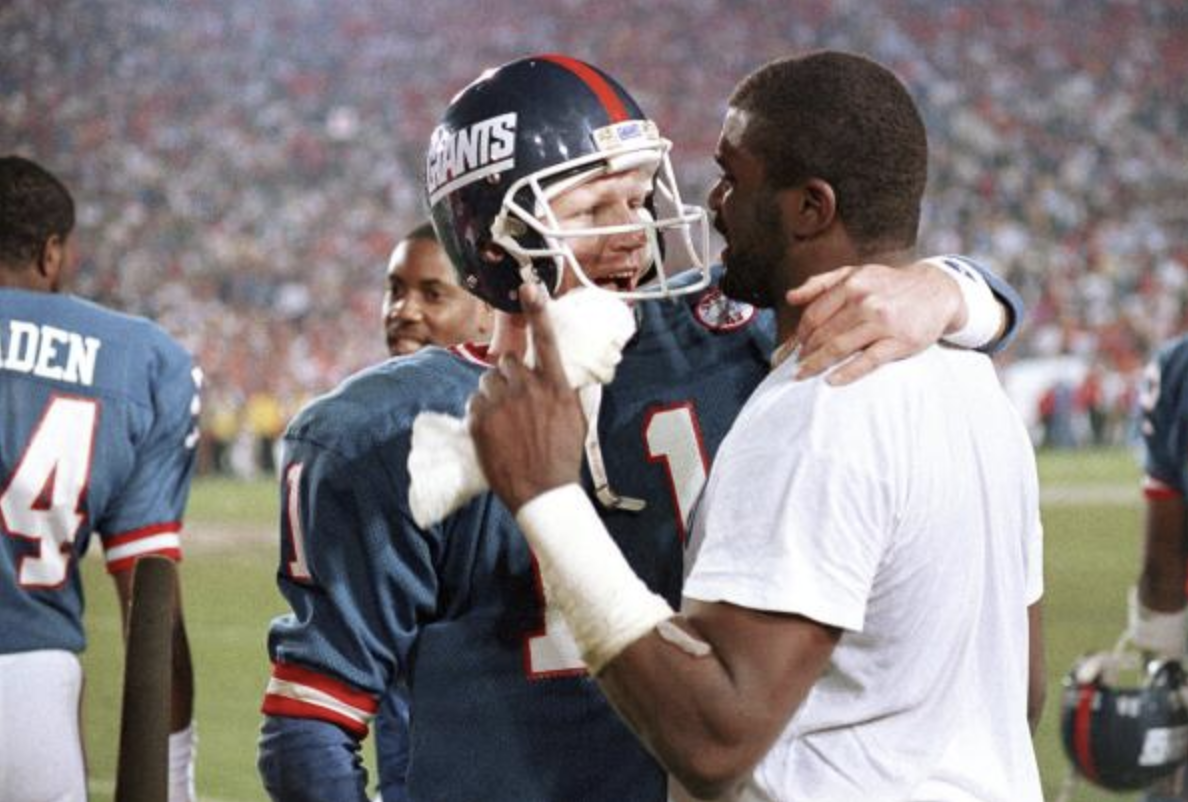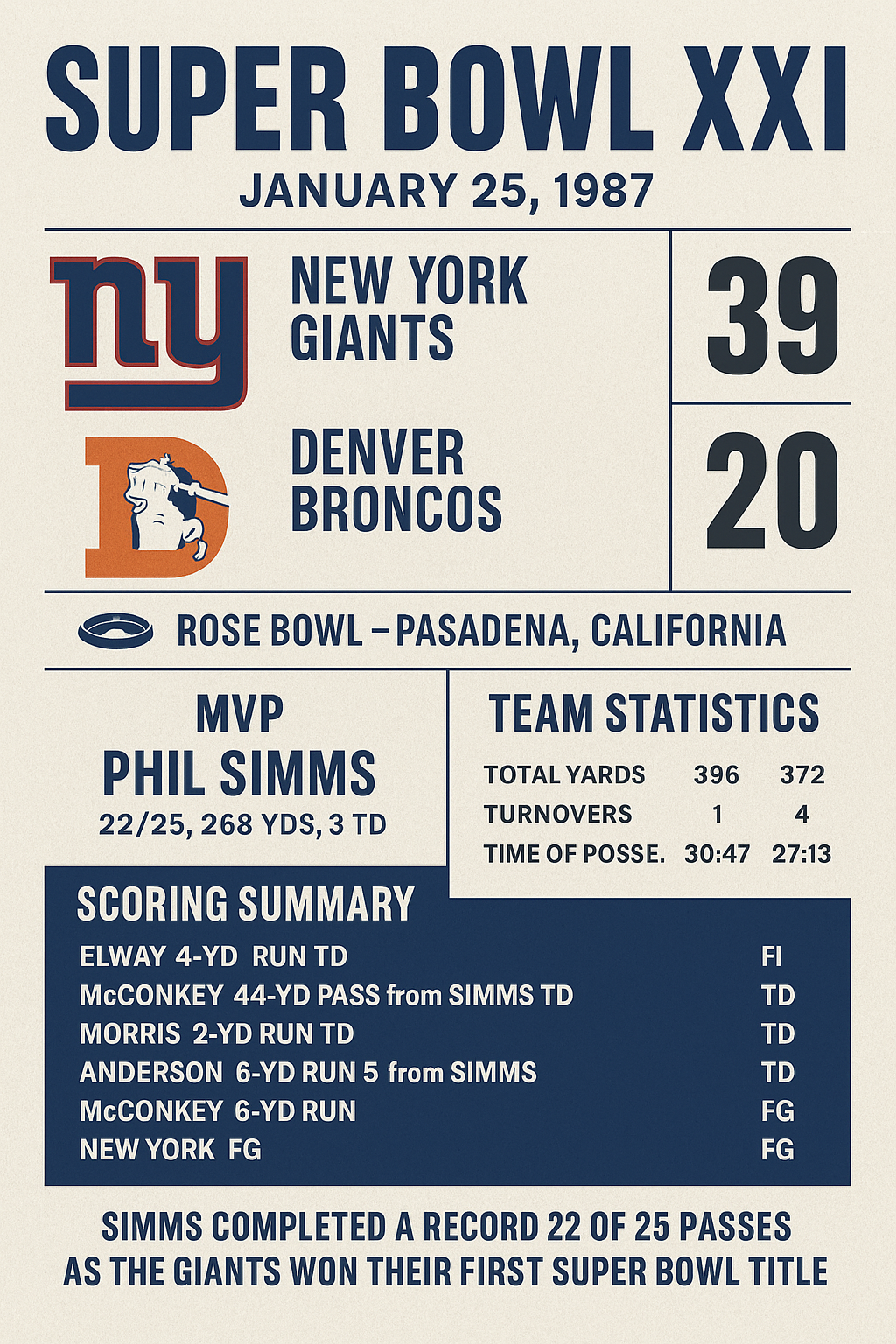Super Bowl XXI: Simms Shines as Giants Rise in Pasadena

On January 25, 1987, at the Rose Bowl in Pasadena, California, the New York Giants cemented their place in football history by defeating the Denver Broncos 39–20 in Super Bowl XXI. For the Giants, it was their first Super Bowl title and their first NFL championship since 1956. Led by head coach Bill Parcells, quarterback Phil Simms, and the feared “Big Blue Wrecking Crew” defense, New York proved too physical, too prepared, and too polished for the upstart Broncos.
In the process, Simms delivered one of the most precise quarterbacking performances in Super Bowl history, and the Giants kickstarted a legacy of defensive dominance and gritty postseason football that would echo for decades.
The Setup: Two Gritty Teams, One Historic Opportunity
The New York Giants came into the game with a 14–2 regular season record and a reputation for defensive dominance. Anchored by stars like Lawrence Taylor, Carl Banks, and Harry Carson, the Giants allowed the fewest points in the league and had just steamrolled through the NFC playoffs, including a 49–3 blowout of the 49ers and a shutout of Washington.
The Denver Broncos, led by third-year quarterback John Elway, had gone 11–5 and made history in the AFC Championship by staging "The Drive"—a legendary 98-yard march to defeat the Browns in overtime. It was the Broncos' second Super Bowl appearance and Elway’s first.
With the Giants’ rugged defense and Denver’s never-say-die quarterback, the stage was set for a classic.
“Super Bowl XXI was billed as a brawl versus brilliance,” said Dr. Louis Mendez, senior curator at the Super Bowl Historical Society. “What we got was a masterclass in balance, poise, and how a quarterback can rise above the noise when it matters most.”
The First Half: Missed Opportunities and Defensive Chess
The game opened with both teams trading field goals. On Denver’s second drive, Elway showed flashes of his brilliance, scrambling for a 4-yard touchdown run, giving the Broncos a 10–7 lead.
The Broncos were winning the field position battle and outgained the Giants in total yards during the first half. But their inability to convert inside the red zone would prove costly. Kicker Rich Karlis missed two field goals—one hitting the upright—and Denver settled for only three points on multiple long drives.
The Giants responded with key halftime adjustments, but before heading to the locker room, they executed a gutsy fourth-down fake punt to shift momentum. At halftime, the score was 10–9, with Denver clinging to a narrow lead.
The Turning Point: Halftime Adjustments
Bill Parcells, known for his emotional intelligence and attention to detail, challenged his team at the break. He instructed defensive coordinator Bill Belichick to dial up more pressure, and he unleashed Phil Simms with quicker passing concepts to neutralize Denver’s pass rush.
What followed was the most productive offensive half in Super Bowl history at that point.
“Parcells coached like a man who’d already been there twice before, even though this was his first,” noted Susan Kintz, game film analyst at the Super Bowl Historical Society. “Every move after halftime was a checkmate.”
Second Half: Simms Seizes the Moment
The third quarter belonged entirely to the Giants. On their opening drive, Simms threw a bullet to tight end Mark Bavaro, setting up a 6-yard touchdown run by Joe Morris. That gave New York a 16–10 lead.
On the ensuing possession, the Giants defense overwhelmed Elway, forcing a quick punt. Simms responded with a 58-yard touchdown pass to Phil McConkey that bounced off another receiver and landed in McConkey’s hands inside the 5-yard line. Simms later hit tight end Zeke Mowatt for a score, extending the lead to 26–10.
The Giants kept attacking. Running back Ottis Anderson punched in another touchdown, and McConkey scored on a reverse sweep, pushing the game to 39–13 before a late Elway touchdown made the final score more respectable.
Final Score
- New York Giants: 39
- Denver Broncos: 20

MVP and Notable Performances
Phil Simms was named Super Bowl XXI MVP, and for good reason:
- 22 completions on 25 attempts
- 268 passing yards
- 3 touchdowns
- No interceptions
- 150.9 passer rating (the highest in Super Bowl history at the time)
Simms completed 88% of his passes—a record that still stands today for Super Bowl performance. Every throw seemed to hit a receiver in stride, and his timing was impeccable.
Key contributors:
- Joe Morris: 67 rushing yards, 1 TD
- Mark Bavaro: 4 catches, 51 yards
- Phil McConkey: 2 catches, 50 yards, 1 TD, 1 rush TD
- Lawrence Taylor: 6 tackles, constant pressure
- Carl Banks: 10 tackles, 1 sack
- John Elway (DEN): 22/37, 304 yards, 1 TD, 1 INT, 27 rushing yards, 1 rushing TD
- Vance Johnson (DEN): 5 catches, 121 yards
Despite Elway’s efforts, the Broncos were overwhelmed by a relentless front seven and a well-coordinated offense.
Coaching Breakdown: Parcells and Belichick’s Blueprint
Bill Parcells became the first Giants head coach to win a Super Bowl, and his leadership style—discipline combined with adaptability—set the tone for a franchise-defining win.
Meanwhile, Bill Belichick, then in his mid-30s, devised a second-half defensive scheme that threw off Elway’s rhythm. Using disguised coverages and selective blitzes, he helped shut down Denver’s offense for nearly two quarters.
On offense, coordinator Ron Erhardt kept the Broncos guessing by mixing short curls, bootlegs, and misdirections—giving Simms options to avoid the pass rush.
Strategic Takeaways
- Red zone execution is critical: Denver missed two field goals and failed to score touchdowns on long drives.
- Halftime adjustments win games: The Giants outscored the Broncos 30–10 in the second half.
- Quarterback precision beats pressure: Simms' record-setting accuracy neutralized Denver’s pass rush.
- Versatility matters: Simms, Bavaro, McConkey, and Morris each played different but vital roles.
Cultural and Historical Significance
Super Bowl XXI was a watershed moment for the New York Giants franchise. After years of being overshadowed by the Jets and haunted by past postseason failures, they had finally captured the Lombardi Trophy.
Phil Simms, often maligned as average, instantly became a Giants legend. His near-perfect performance shattered the narrative and earned him a place in Super Bowl lore.
For Bill Parcells, the win validated his transformation of the Giants from a perennial underachiever into a fearsome, disciplined powerhouse. It also laid the foundation for the coaching tree that would shape the NFL for decades—including names like Belichick, Tom Coughlin, and Sean Payton.
Broadcast and Media Notes
Super Bowl XXI aired on CBS, with the dynamic duo of Pat Summerall and John Madden in the booth. The broadcast drew over 87 million viewers, making it one of the most-watched programs of the decade.
The game was also the first Super Bowl to feature on-field postgame interviews and trophy presentation, a tradition that continues today.
Legacy: Birth of Big Blue’s Modern Era
The Giants would go on to win another Super Bowl just four years later under Parcells. They became known for elite defense, physical toughness, and clock control—traits that continued under successors like Coughlin in the Eli Manning era.
Phil Simms, though plagued by injuries later in his career, is remembered for this single, shining moment—22 for 25, Super Bowl MVP, and the author of a championship legacy.
As for the Broncos, it was a familiar pattern. Elway would go on to lose two more Super Bowls before finally claiming his first in Super Bowl XXXII, over a decade later.
“Simms didn’t just have a great game—he had the game,” said Dr. Mendez. “When the lights were brightest, he threw the sharpest. That’s how legacies are born.”
Final Thoughts
Super Bowl XXI wasn’t a last-second thriller or a wild shootout. It was a testament to preparation, adjustment, and flawless execution. The Giants rose to the moment with toughness and precision, and Phil Simms delivered one of the finest performances in Super Bowl history.
They came to Pasadena as challengers. They left as champions—and legends.
